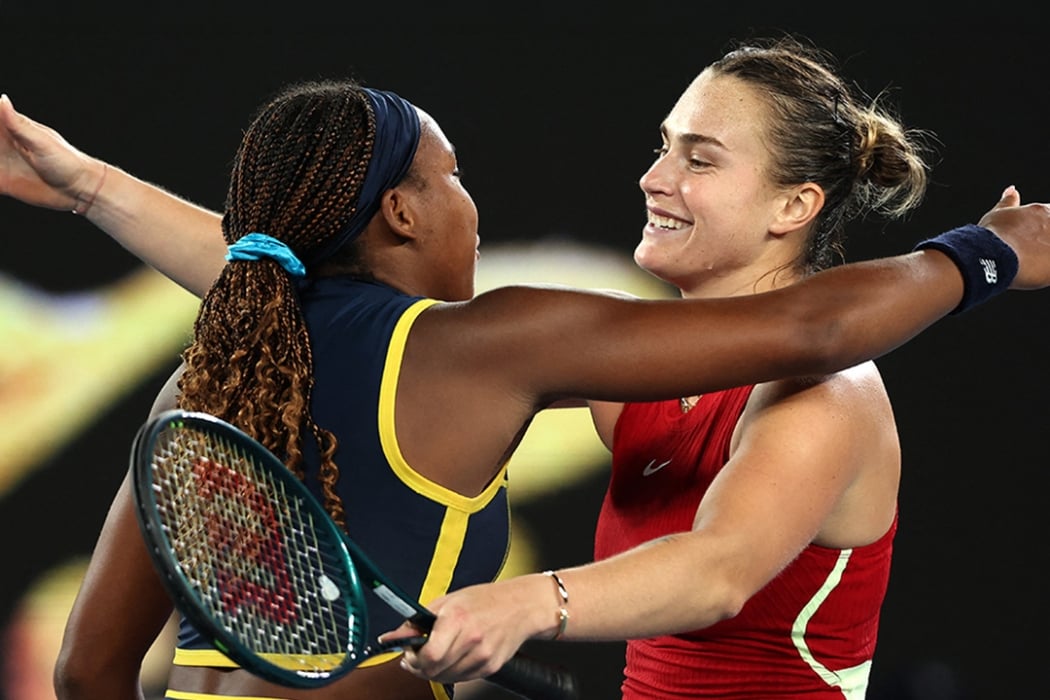A small sign labelled ‘Stringers’ leads to a windowless room off one of the cool and dimly-lit corridors underneath Rod Laver Arena, where players at Australian Open 2025 move unencumbered by the bright sun, bustling crowds and frivolity of the tournament outside.
In this room is American Julian Li, one of 22 stringers from 13 countries working at this year’s tournament for Yonex.
Li is standing behind a Yonex Precision 9.0 machine that will be his desk for the first Grand Slam of the season. Each stringer has their own machine, with their name and country of origin attached to the front of it.
Li’s stringing a racquet for Vasek Pospisil. We know that, because attached to the handle of the racquet with a rubber band is a printed label. It includes the player’s name and the two types of string and the thickness they want for the ‘main’ and ‘cross’.
“The silver stuff is polyester,” explains Li. “This,” he continues, pointing to the horizontal string he is handweaving, “is made out of cow intestine, the cross is. So it’s a lot more delicate, this is natural gut."

The label also includes the tension the player wants the strings at, which is measured in pounds, a pre-stretch percentage, number of knots, ‘stencil’, or logo, to be added, and when it will be collected.
“Those are the important things,” Li says.
“Sometimes they are very specific, they want their stringer tonight for tomorrow, sometimes they don’t want you to string it tonight, they want you to string it in the morning, they want those strings really fresh.
“But some players don’t want that, they want you to string it the night before, so sitting around, the string’s going to loosen up about one-and-a-half pounds tension, that’s what they’re used to. As long as they tell us, we’ll deliver that.”
The Precision 9.0 machine measures and sets the tension, Li says down .1, and clamps hold the polyester and gut in place as the stringers diligently handweave, tie and knot each individual string you see on the finished product.
“We put it [the racquet] on the machine, we dial in the tension on the label, and then we’ll put the mains in, do the mains and finish that, tie off, start the crosses and just make sure all the strings are straight, we didn’t make any mistakes,” Li explains.
“Make sure we change the tension if there’s a tension change. Sometimes the players will have different tension on the mains and the crosses.”
Li has almost finished Pospisil’s racquet. Now with a blunt awl in hand (it looks like a screwdriver), he pushes it through the small individual squares on the freshly stringed racquet, to ensure the strings are straight.
It’s a job that takes dexterity, endurance, and teamwork. These men and women work in close quarters and many just a few days into Opening Week are still fighting jetlag, in yet they’ve already strung 2042 racquets – a number that is expected to grow to over 7000 by the end of the major.
“It’s a skill,” says Li. “Some guys are really fast in here. Everybody is going to take around 15 minutes per racquet.”
Li has flown 16 hours to arrive at Melbourne Park – the same time as some of his days at the tournament will be.
“We’re going to be here for well over 12 hours, sometimes 16 hours, pretty much [every day],” he says. “Right before main draw starts, it’s like a zoo in here. But everybody’s got their job to do, and we just have to do it and get it done.”
It’s obvious that Li takes great pride in his work. What started out as personal interest, stringing his own racquets in his garage, has become an occupation that’s taken him around the world and led to lasting friendships.
“We have this great opportunity thanks to Yonex. This is my ninth [AO], sixth with the team. I was a personal stringer for Yonex before, taking care of the Yonex players exclusively, but now it’s impossible, there’s so many Yonex players,” he says.
The technology involved has also changed. Yonex’s machines are far superior to days of old, where bicep strength was once how string tension was measured.
“That was three tensions. It would be loose, medium and tight. And usually, the owner of the shop would do it tight because he’s the strongest, the apprentice would do it the loosest,” Li says. “We don’t do that anymore.”
Li has no time to talk about the competition. More racquets are coming in. But he’s humble about the importance of the work he does. Asked if stringers can be the difference between a win or loss, he quips: “You can’t guarantee a win, but you can definitely guarantee a loss if it’s done improper.
“I’m just stringing racquets. If I could make them win or lose, I wouldn’t be here!”

